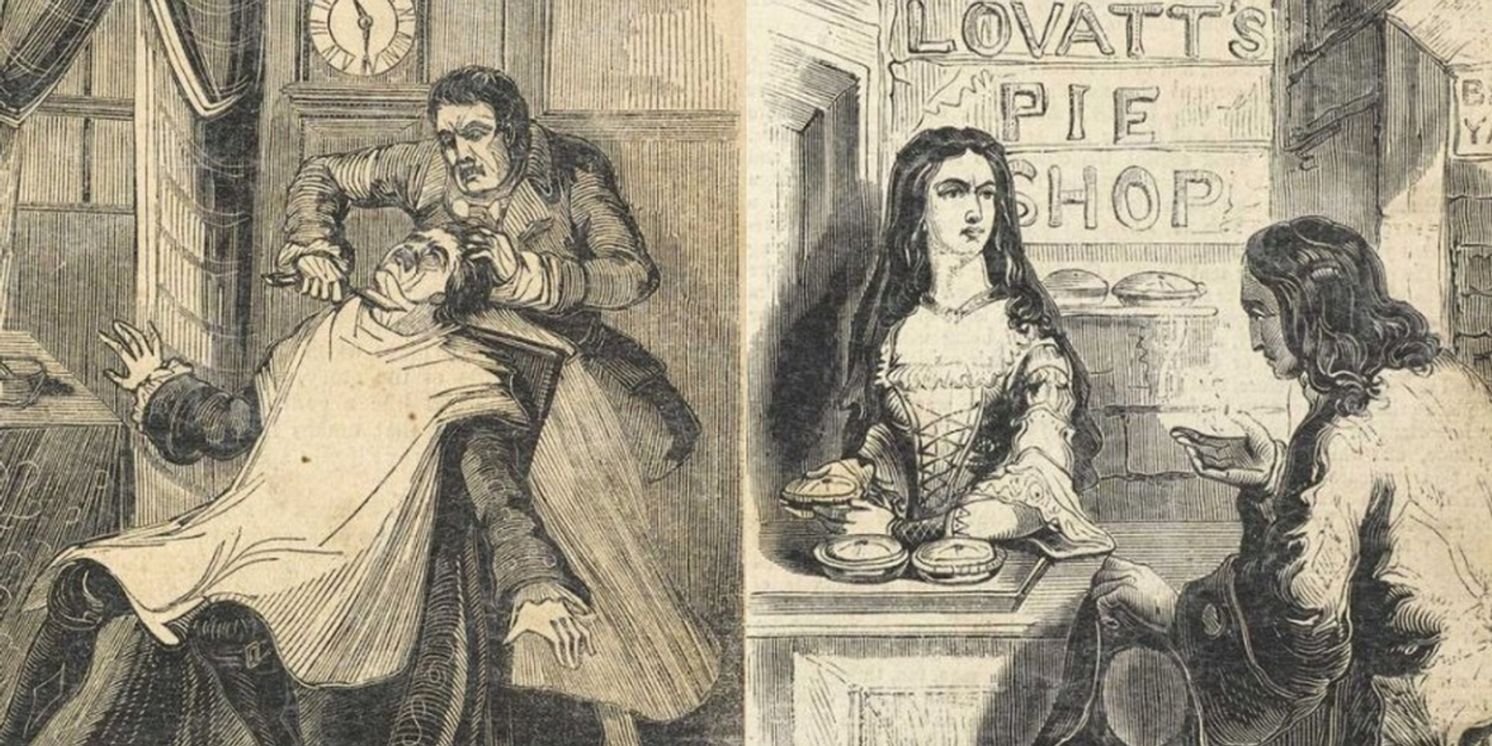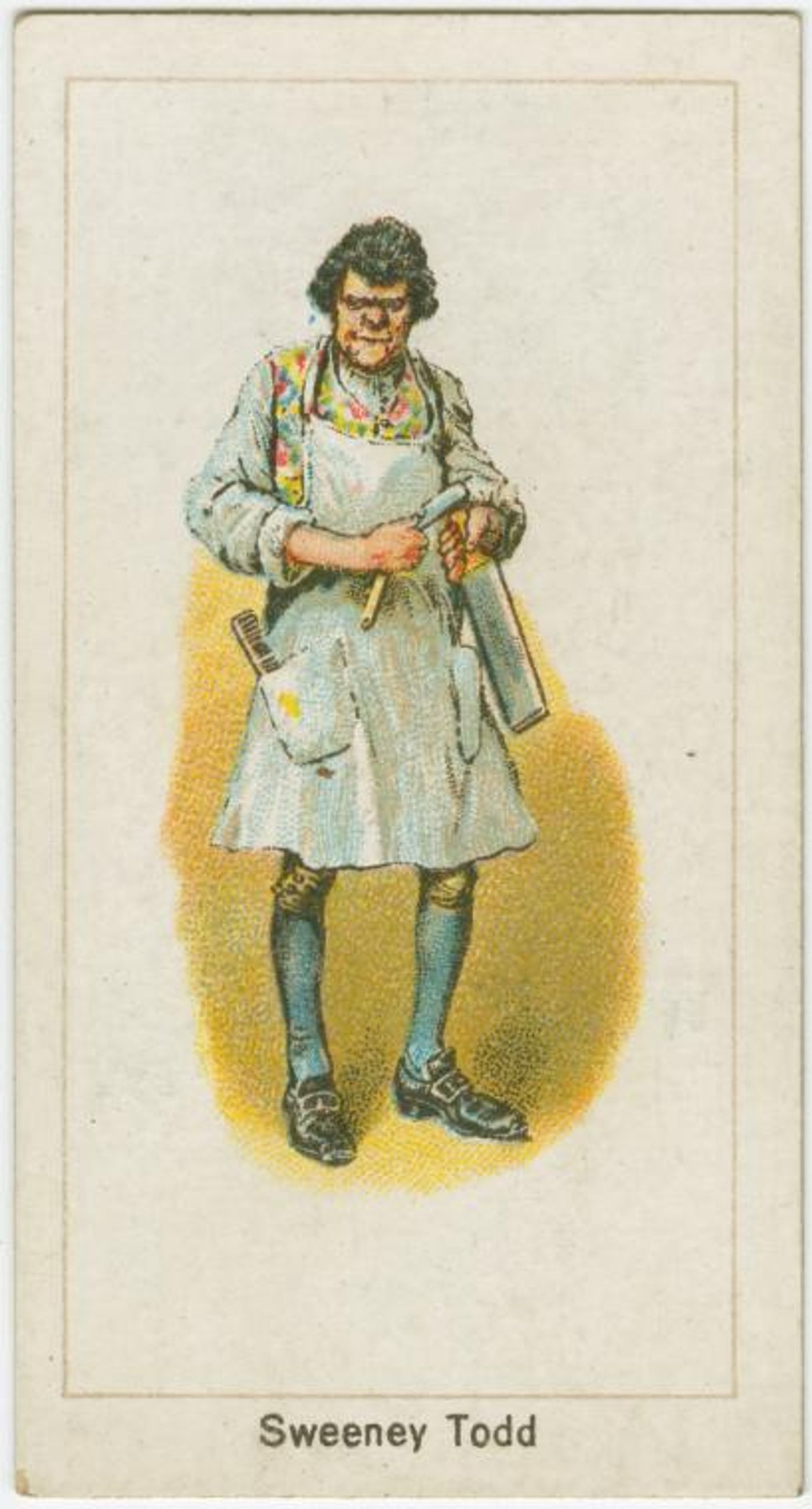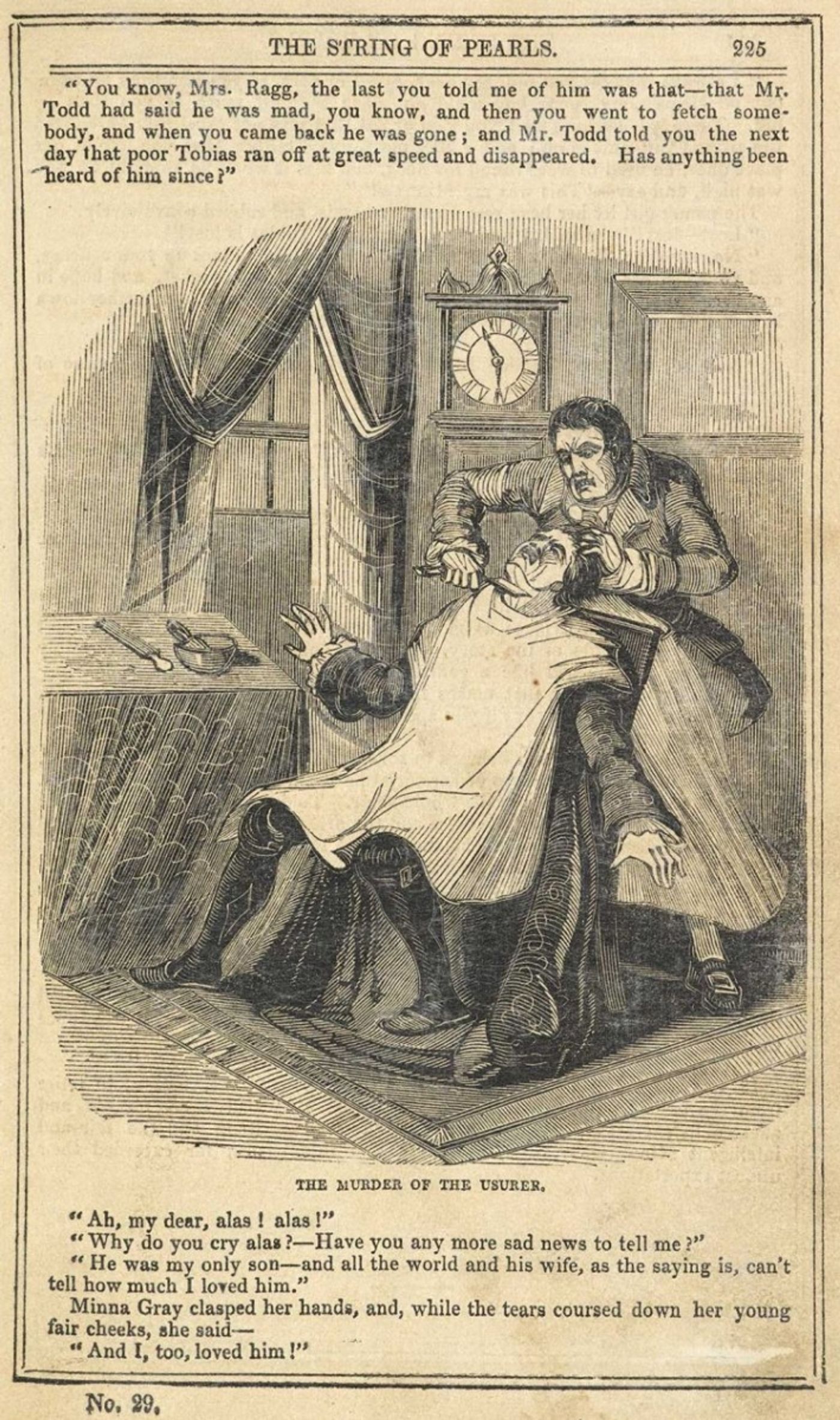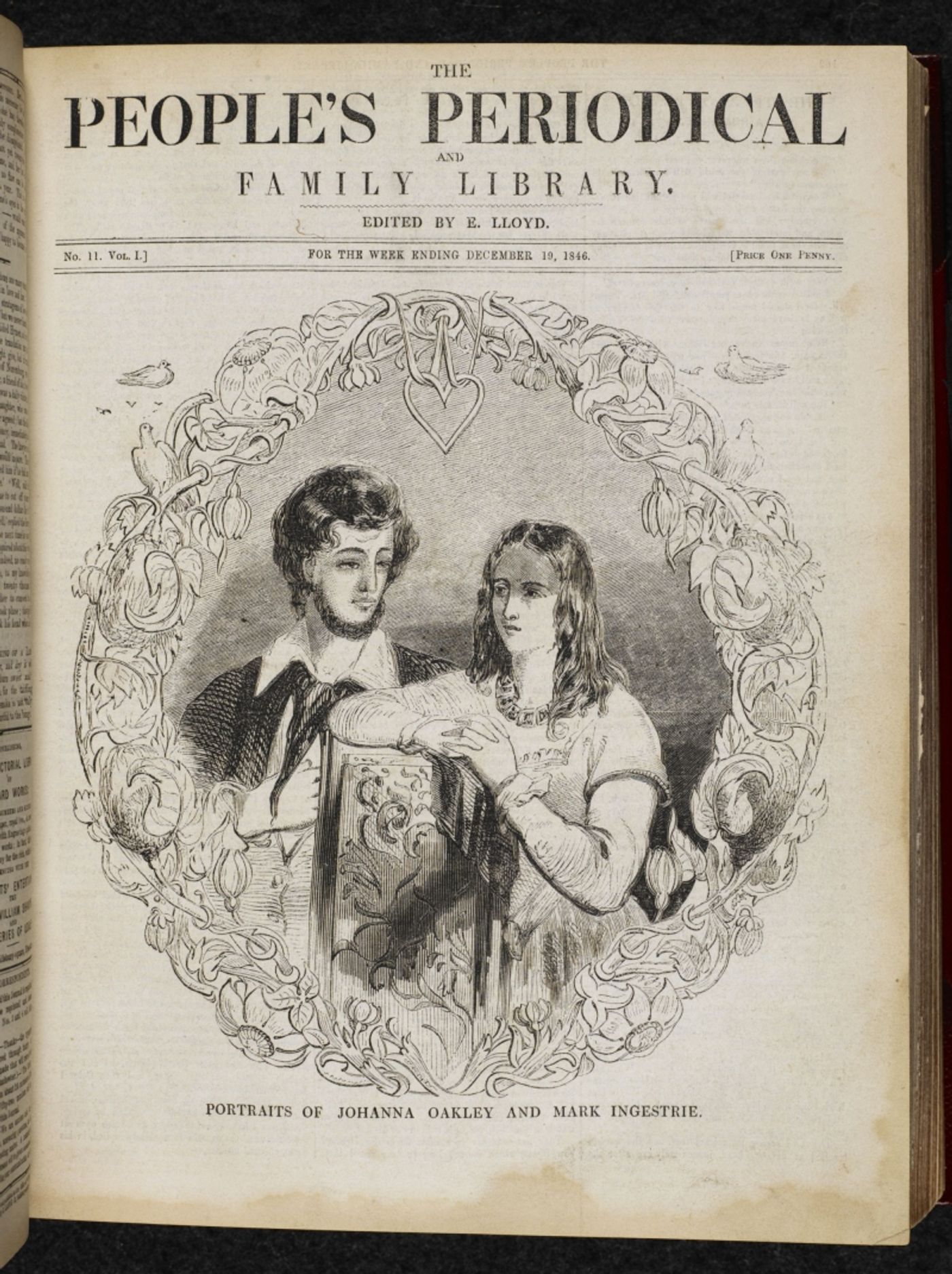SWEENEY TODD, A History- Part 1: Murder, Meat Pies, Men and Myths
Attend the true tale of Sweeney Todd as we delve into the history of how the story of the Demon Barber of Fleet Street came to haunt our nightmares.

Spring, 1979. The Uris Theatre. A packed house has turned up to attend the latest offering from Broadway’s hottest duo, composer Stephen Sondheim and director Harold Prince. The pre-Internet age has yielded very little information about the piece, regarded as Broadway’s first horror musical and expectations are high. The auditorium is a-buzz with anticipation for the next offering from the most acclaimed duo of the day.
With pre-show excitement at a fever pitch, the house lights dim and a Dracula-esque organ prelude plays in place of an overture. Stage lights come up to reveal silk banner illustrating the British class system of the Victorian era hanging from the rafters. Two workers enter and aprubtly tear the banner down, triggering a large factory whistle set at the lip of the stage, jolting the audience with the first of many nerve-shredding howls of the evening. The now-rattled crowd gathers their faculties and adjusts their eyes as a dim light fills the stage illuminating the show's ensemble, a murmuring, undulating musical intro rolling in like a dense fog. Still shaken from their encounter with the whistle, the audience leans in to hear every detail of Sondheim’s lyrical campfire story about this mysterious and murderous barber, Sweeney Todd, his pale skin and odd eye taking shape in their minds. After a moment, they ease back into their chairs, feeling safe at last, and are swiftly met with the first thunderous blast of Jonathan Tunick’s 26-piece orchestra and Hal Prince’s 27-person ensemble delivering the first, “Swing your razor wide” with near gale force. As the musical jump scare lands, they are launched into the tale of Sweeney Todd, the Demon Barber of Fleet Street.
Since 1979, Stephen Sondheim’s take on the Victorian myth about an exiled barber who pairs up with a cunning pie maker to seek revenge on the men who wronged him has delighted and enthralled audiences with its thrilling score, pitch black humor, and chaotic plot, but what is the real story behind this penny dreadful turned musical delight? Was there a real Sweeney Todd? Where did the story come from? And, most pressingly of all, what inspired Sondheim to spin this nauseating nightmare into gothic musical comedy gold? The answers just might surprise you as we delve into the history of Sweeney Todd.
Though the tale of Sweeney Todd has long been dismissed as a myth, two books by journalist Peter Haining asserts that the murderous barber was, in fact, a real person. The following is Haining’s account, said to have been based on 25 years of research, of the life of the man whom he claims was the real Sweeney Todd.
Peter Haining asserts that the murderous barber was, in fact, a real person. The following is Haining’s account, said to have been based on 25 years of research, of the life of the man whom he claims was the real Sweeney Todd.
Sweeney Todd was born on 16th October 1756 and made his way into the world by way of two alcoholic silk winders. A product of neglect and abuse, Todd hated his parents and spent hours in the Tower of London museum, examining its collection of medieval instruments of torture with unique fascination to escape his miserable living situation. Todd’s parents mysteriously disappeared in the freezing winter of 1768, possibly dying on the streets while seeking their next drink.
Todd said of his parents, "My mother used to make quite a pet of me. I was fondled and kissed and called a pretty boy. I used to wish I was strong enough to throttle her. What the devil did she bring me into this world for, unless she had plenty of money to give me so that I might enjoy myself in it?"
Todd turned up again the following year as an apprentice, working under John Crook of Holborn, a cutler specializing in razors. He was jailed in Newgate Prison for five years in 1770, at the age of 14 for the crime of petty theft.. During his stay in Newgate, Todd worked as the institutional barber’s assistant, helping to prepare prisoners for execution.
Following his release, Todd returned to London at the age of 19, where he began a career as a street corner barber before opening a shop of his own near Hyde Park. He employed a young woman as a shop assistant. Though there is no record of the pair ever marrying, he is said to have referred to her as his wife and she began to bear the brunt of his growing rage and violence in their home.
Todd perpetrated his first murder in December 1784. Haining provided the following quote found among historical records of the publication The Annual Register as proof of the crime, “A young gentleman, by chance coming into the barber's shop to be shaved and dressed, and being in liquor, mentioned having seen a fine girl in Hamilton Street, from whom he had had certain favours the night before. The barber, concluding this to be his wife, and in the height of his frenzy, cut the young gentleman's throat from ear to ear and absconded."
Though there is no official record of the name of the killer, a man Haining believed to be Todd is said to have claimed the killing years later, stating, "My first 'un was a young gent at Hyde Park Corner. Slit him from ear to ear, I did."
Following this incident, Todd turned up on the infamous Fleet Street where he would combine, in Haining's terms, “the ingenuity of a cutler with the skill of a barber” to embark on his killing spree. The cold and crumbling slums of Industrial Age London provided a perfect backdrop for his dark deeds with policing being a fairly recent development and the impoverished and disease-ridden Fleet Street area populated with a cast of peasants, miscreants, and criminals.
Though there is no exact record of the shop’s address, it is speculated that it was located at 186 Fleet Street beside St Dunstan's Church. Todd leased the dilapidated storefront for £125 and advertised himself as a “barber and surgeon,” a common duality of the age. It is said that his shop contained numerous jars displaying coagulated blood and human teeth to advertise his medical and dental services.
Much like his musical counterpart, Haining's barber is described as “sullen, with heavy eyebrows, a hard mouth and pugnacious features.”
A gentleman’s magazine published in 1853 wrote of Todd, "There was also something very sinister about him with his pale face and reddish hair. At times he was like some hobgoblin, his strange, dark eyes agleam with greed and cunning."
According to an article in the Daily Courant on April 14, 1785, Todd’s first Fleet Street murder was that of a young gentleman who had fallen into a doomed argument with the unhinged barber.
It said: "The two men came to an argument, and of a sudden the barber took from his clothing a razor and slit the throat of the young man, thereafter disappearing and was seen no more."
clothing a razor and slit the throat of the young man, thereafter disappearing and was seen no more."
Haining attributes numerous deaths to Todd during this time, including those of an apprentice, a pawnbroker, a share dealer, and a petty crook. Haining writes that Todd was also a thief, robbing the corpses of his victims of their valuables.
It was also during this time, Haining says, that the barber employed another familiar tactic- the use of a revolving chair to dispatch his victims. The only authentic account of a victim being murdered in the chair is recorded in an incomplete handwritten document, reported by a man whose father, Thomas Shadwell, may have fallen victim to Haining's Sweeney as his gold pocket watch was later found at 186 Fleet Street.
With his body count rising, Haining surmises that Todd sought a new way to dispose of the corpses of his victims. It was at this time that he encountered a young baker and widow named Mrs. Lovett, first name unknown. Later stories ultimately settle on Nellie, but according to Haining historical records point to Margery or Sarah as her first name.
The psychosexual bond between the two kindred spirits was immediately apparent, with Lovett harboring a penchant for strong, violent men and Todd fitting the bill perfectly. The two began their gruesome affair, with Todd using the tunnels beneath the shop to transport the flesh and organs of his victims to Lovett’s bake shop where she, in turn, used them as filling for her wildly popular meat pies.
In their plotting, however, the two made a fatal error, leaving bones to rot in a disused family vault under St. Dunstan’s church. The smell of rotting flesh, along with rumors of sailors disappearing from the barber shop, attracted the attention of local law enforcement who began monitoring their activities. After some surveillance, police began investigating the strange odor emanating from the church and soon located a number of vaults containing the recent remains of human bodies.
 Continuing their search, police made their way through the tunnels to the underground bakehouse where Mrs. Lovett prepared her pies. The horrific discovery soon led Blunt and his team to the nauseating reality that not only was Todd a mass murderer, but the two had been using their victims as filling for Lovett’s pies. In later searches of the shop, investigators also unveiled a collection of valuables belonging to his victims.
Continuing their search, police made their way through the tunnels to the underground bakehouse where Mrs. Lovett prepared her pies. The horrific discovery soon led Blunt and his team to the nauseating reality that not only was Todd a mass murderer, but the two had been using their victims as filling for Lovett’s pies. In later searches of the shop, investigators also unveiled a collection of valuables belonging to his victims.
Upon her arrest, Mrs. Lovett confessed to the crimes as a willing accomplice leading Blunt and his men to take Todd into custody, jailing him, once more, in Newgate. As law officials prepared their case, Mrs. Lovett is said to have killed herself with poison, likely purchased from a prison guard.
The news of their crimes gripped the people of London with crowds gathering around Fleet Street to hear the latest gossip on what The Daily Courant called "one of the trials of the age".
The salacious trial is documented as part of the weekly accounts in the Newgate Calendar of Prisoners (or Malefactor's Bloody Register). According to Haining, the reports prove beyond doubt that Todd existed.
At first, Todd was charged with a single murder, that of Francis Thornhill. Prosecutors described how Thornhill had been commissioned to deliver a string of pearls worth £16,000 to a young woman in London but had gone missing after going into Todd’s shop for a shave. The barber later pawned a string of pearls similar to the necklace for £1,000.
The Attorney General unfolded his case, then revealed that the clothing of around 160 people was found in Todd's shop. The prosecution was also able to tie a leg bone found in the underground vault belonged to the missing Thornhill, bringing forth a surgeon, Sylvester Steers, who had treated Thornhill for a fracture and recognised the bone as the one belonging to his patient.
It took less than five minutes for the jury to deliver a guilty verdict. It is said that pandemonium broke out in the courtroom upon the ruling. The Newgate Calendar wrote of the scene, "All eyes were turned upon the most dastardly criminal of the age, Sweeney Todd, who stood in the dock glaring at the foreman of the jury."
Upon sentencing Todd to death, the judge placed a black cap upon his head, stating, "You.png?format=auto&width=1400) cannot expect that society can do otherwise than put out of life someone who, like yourself, has been a terror and a scourge."
cannot expect that society can do otherwise than put out of life someone who, like yourself, has been a terror and a scourge."
On the morning of January 25, 1802, the 46 year-old Todd was hanged on a scaffold in front of a crowd of thousands of onlookers. His body is said to have hung in place for an hour before it was brought to the Royal College of Surgeons in the Old Bailey for dissection.
Though Haining’s account is compelling, it has been challenged on a number of levels with historians calling into question some of his conclusions, citing a lack of hard evidence for a number of his claims as well as the fact that the first murder attributed to Todd has never been officially assigned to anyone.
Additionally, there are other, historical factors that come into play when examining the veracity of these claims, the main ones being that no public records have ever substantiated the existence of a London barber named Todd in the late 18th century or a barber shop located on Fleet Street.
There are, however, some signs that point to the likelihood that Sweeney’s story could have been based in some truth, as the one-sheet tabloids or ‘broadsides’ of the day specialized in gruesome true crime tales for a public who devoured them. With much of the population still illiterate, the shocking details of these crimes likely traveled via word of mouth, acquiring embellishments from person to person.
In addition, the genre that spawned the tale, ‘penny dreadfuls’ were often fictionalized accounts of real crimes. Printers of these periodicals were also known to advertise such tales as based on or inspired by true stories to enhance their effectiveness, as well as their sales. Thomas Prest, the writer often credited with the first official printed mention of the name Sweeney Todd, was known to hunt regularly through newspapers for his story ideas and there were several stories of the day that just may point to Sweeney’s origins.
In addition to the earlier quote attributed to The Annual Register, The Newgate Calendar, also recounted the gruesome story of the mass-murderer Sawney Bean, also known as the "Man-Eater of Scotland." According to the account, Bean and his entire family were executed for robbing and murdering their victims before eating their remains.
In the 1800s, Parisian Minister of Police, Joseph Fouche, documented a series of murders committed by a Parisian barber in his Archives of the Police. Fouche wrote that a local barber and neighboring pastry cook had worked together to make pies out of the former’s victims and sold them to unsuspecting customers for consumption. While there is some speculation about the account’s authenticity, the story was republished by London magazine The Tell Tale in 1824 with the title, "A Terrific Story of the Rue de Le Harpe, Paris".
Another potential origin for the tale is an 1818 libel lawsuit in which scandalmonger James Catnatch was sued after nearly driving a Drury Lane butcher out of business after publishing a story with the headline, "A Number of Human Bodies Found in the Shop of a Pork Butcher". A local butcher, Thomas Pizzey filed a libel suit against Catnatch in retaliation, calling attention to the publisher's corrupt practices and dubious ethics. According to the lawsuit, Catnatch had a history of publishing fake news, rumor, and innuendo in order to juice sales of his one-page news sheets. A Clerkenwell court ultimately found Catnatch guilty of libel, thus restoring Pizzey’s good name and earning Catnatch a stay of six months in the House of Correction for his crime. Court documents described Catnatch as an "evil, wicked" person with a "malicious mind and disposition.
There is one other instance of a potential origin for the tale of Sweeney Todd and it points to another of the era's great storytellers- Charles Dickens.
The original Todd tale was originally published in Edward Lloyd's magazine The People's Periodical and Family Library under the title, The String of Pearls: A Domestic Romance, or The Sailor's Gift. Lloyd had begun his career a decade earlier, publishing plagiarized Dickens works, including well-disguised versions of Oliver Twist and Nicholas Nickelby.
Todd has been said to be a take on Daniel Quilp, the malignant dwarf from Dickens’s The Old Curiosity Shop, while other scholars point to his work The Life and Adventures of Martin Chuzzlewit as inspiration for Sweeney's story. In that novel, the character Tom Pinch is convinced that country visitors to London are regularly lured into unfamiliar quarters where they are "made meat pies of, or some horrible thing" with Pinch grateful that "evil genius did not lead him into the dens of any of those.jpg?format=auto&width=1400) preparers of cannibalic pastry, who are represented in many standard country legends, as doing a lively retail business in the metropolis."
preparers of cannibalic pastry, who are represented in many standard country legends, as doing a lively retail business in the metropolis."
The novel also includes a character by the name of Poll Sweedlepipe who "was an easy shaver also, and a fashionable hair-dresser." His premises are noted as being "next door but one to the celebrated mutton-pie shop, and directly opposite to the original cat’s meat warehouse; the renown of which establishments was duly heralded on their respective fronts." An illustrations for the novel shows Sweedlepipe’s shop, a sign advertising ‘Easy Shaving’ hanging in the window with the "Mutton Pie Depot" as its neighbor, ornamented with a signboard in the shape of a mutton pie.
In Pickwick Papers, the servant Sam Weller says that a pieman used cats "for beefsteak, veal, and kidney, 'cording to the demand", and recommends that people should buy pies only "when you know the lady as made it, and is quite sure it ain't kitten."
The String of Pearls was published as a serial horror drama, presented in 18 weekly parts from November 1846 to March 1847. The tale has been credited to the aforementioned Thomas Peckett Prest, James Malcolm Rymer as well as Edward P. Hingston, George Macfarren, and Albert Richard Smith.
 Set in London in the year 1785, the plot concerns the mysterious disappearance of a sailor named Lieutenant Thornhill, who goes missing after entering Todd’s shop on his way to deliver a string of pearls to a young woman by the name of Johanna Oakley on behalf of her missing lover, Mark. Alerted to his disappearance, one of Thornhill’s colleagues, Colonel Jeffrey and his faithful companion, a dog named Hector, team up with Johnna in search of the whereabouts of the two missing men.
Set in London in the year 1785, the plot concerns the mysterious disappearance of a sailor named Lieutenant Thornhill, who goes missing after entering Todd’s shop on his way to deliver a string of pearls to a young woman by the name of Johanna Oakley on behalf of her missing lover, Mark. Alerted to his disappearance, one of Thornhill’s colleagues, Colonel Jeffrey and his faithful companion, a dog named Hector, team up with Johnna in search of the whereabouts of the two missing men.
Suspicious of the barber shop where Thornhill was last seen, Johanna disguises herself as a boy and takes a job as an assistant in Todd’s shop, replacing his last employee, a young man by the name of Tobias Ragg who had been incarcerated in an asylum for accusing Todd of murder, despite the truth in his accusations.
Upon Johanna’s arrival, Todd and a baker called Mrs. Lovatt are already in the business of manufacturing meat pies out of Todd’s victims who are dispatched to her bakehouse by way of his weapon of choice- a lever-activated, revolving chair. In the earliest incarnations of the tale, Sweeney's ingenious killing machine rolls backward, causing his seated victims to crack their heads or break their necks as they are flipped headfirst onto the stone cellar floor. Todd then follows up with his straight razor to ensure that his work is complete.
Mrs. Lovatt and Todd’s crimes are eventurally uncovered due to the smell of burning bodies, at which time Johanna’s lover, Mark, is revealed as Mrs. Lovatt’s prisoner, having been locked away in the bakehouse and forced to work as a cook for the entirety of the story.
Mark ultimately escapes via a lift used to bring the pies up from the cellar into the pie shop to reveal the hideous truth of Mrs. Lovatt’s wares to a dining room full of customers. He states, "Ladies and gentlemen – I fear that what I am going to say will spoil your appetites; but the truth is beautiful at all times, and I have to state that Mrs. Lovatt's pies are made of human flesh!” The tale concludes as Mrs. Lovatt ends up as Todd’s final victim, with the barber poisoning her before he is apprehended and hanged.
human flesh!” The tale concludes as Mrs. Lovatt ends up as Todd’s final victim, with the barber poisoning her before he is apprehended and hanged.
Insofar as it is possible, the story does have something of a happy ending as the young lovers, Johanna and Mark, are ultimately wed.
Todd's story became wildly popular, inspiring another, lengthier, penny part serial which appeared in 92 episodes the 1847–1848 issues. A 732-page book titled, The String of Pearls, The Barber of Fleet Street. A Domestic Romance" appeared in 1850 and spawned a plagiarized printing which appeared in the United States as Sweeney Todd: or the Ruffian Barber. A Tale of Terror of the Seas and the Mysteries of the City by "Captain Merry" a pseudonym used by American author Harry Hazel circa 1852–1853. In a nod to the account of Parisian Chief of Police Joseph Fouche, in 1865, French horror and crime novelist Paul H.C. Féval, referred to what he termed "L'Affaire de la Rue des Marmousets" in the introduction to his book La Vampire. A late 1890s reference to the legend of the murderous barber can also be found in the poem by the Australian bush poet Banjo Paterson, "The Man from Ironbark".
Despite its many literary incarnations, however, Sweeney’s story seemed destined for larger venues from the start, jumping from page to stage almost immediately. The first incarnation of Sweeney's story was produced in 1847 before the original serial had even been completed.
“What happened then? Well, that’s the play- and he wouldn’t want us to give it away…”
Follow Sweeney’s story from the slums of Industrial London to the bright lights of Broadway and the Hollywood hills in Part 2 here!
Images:
1) George Arents Collection, The New York Public Library. "Sweeney Todd." The New York Public Library Digital Collections. https://digitalcollections.nypl.org/items/510d47e4-4802-a3d9-e040-e00a18064a99
2) Newspaper clipping from The Annual Register, December 1784
3, 4, 6, 9) The String of pearls; or, The Barber of Fleet Street. A domestic romance, estimated 1850, Salisbury Square, Fleet Street, London, James Malcolm Rymer. Public Domain. Held by British Library.
5) Illustration of Sweeney Todd from the novel "The String of Pearls".
7) “Mr. Pecksniff on his Mission,” Phiz, August 1843. Scanned image by Phillip V. Allingham
8) The People's Periodical, w/e December 19, 1846. No. 11, Vol. 1.
Powered by
|
Videos

